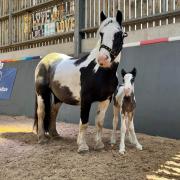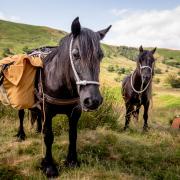An ancient system for training troops in the use of the longbow has been revived in Lancashire

Throughout medieval English history, our longbows struck fear – and some fiendishly sharp arrow heads – into the hearts of our foes.
At Agincourt and Poitiers, against the French, and at Flodden Field, against the Scots, this weapon proved to be diabolically effective, raining terror on opposing armies.
In Lancashire, the skill of the longbow was taught to generations of battle-ready young men. Many of the archers who gathered at Flodden in Northumberland in 1513 were recruited from the red rose county.
Sir Richard Assheton raised a company from the village of Middleton, near Rochdale, and the local parish church, St Leonard’s, contains the unique Flodden Window depicting the archers and their names. It is said to be the country’s oldest war memorial.

According to Lancashire longbow archer Jason Stokes, of Harwood, Bolton, training to shoot the longbow at long distances was known as ‘Roving’ and ‘At the Marks’ and it has been carried out since the Middle Ages.
‘Initially, the bowmen would pick a suitable point to aim for – it could be something like a tree or a gatepost – and they would shoot at them while walking to church or between villages to see who could get the nearest to the mark,’ said Jason, who has been using the longbow for 15 years.
During the late medieval and early Tudor times, archers started to erect permanent ‘marks’ laid out across the fields around the towns and villages. Each of them – wooden shaped and with a painted plaque on top of a post – had its own name and design and was often paid for or attributed to a local guild, business or person. It was, in effect, an early form of advertising.
The longbow men would shoot a course around these marks, to go ‘roving’ and by doing this kept their skill intact during peace time. Shooting at the marks continued as a tradition and for sport well into the 17th century with records showing Charles I competing.
‘Various groups have been formed to keep “The Marks and Rove” shooting traditions alive throughout the UK but most are south of Stoke-on-Trent with one maybe two marks shoots held in Lancashire every now and then,’ said Jason, who shoots once or twice at week with friends at the marks on private land.
‘With all this in mind I decided to and organise a “Marks and Rove” shoot to bring back the tradition to Lancashire. I decided that, as some of the longbow men who fought at Flodden came from Bolton, fighting for Lord Stanley, we should form the “Flodden Marks Rove”.
Each Mark would be the coat of arms of one of the Scottish Lords or Barons who fell on the field of battle.’
That’s why 45 archers – men, women and children – gathered in the carpark of the King William pub near Turton to stage the first event of its kind in living memory. Archers came from across the country to revive the tradition and all agreed that the event hit the mark.
The icing on the cake was to have had the shoot recognised by the Royal College of Arms with an official document to that effect from the Duke of Norfolk.
So any passing Frenchmen or Scotsmen who stray over the border, beware. We are ready for you!



























